#starfleet command ii
Explore tagged Tumblr posts
Text

Saavik sprite for the TWOK DLC of Starfleet Command


#saavik#star trek#s'chn t'gai saavik#star trek tos#star trek ii: the wrath of khan#starfleet command#star trek starfleet command#star trek video games#scotty is there too#montgomery scott#star trek movies
9 notes
·
View notes
Text
When I was a kid, my parents bought me Starfleet Command II in a big box from Sam’s Club.
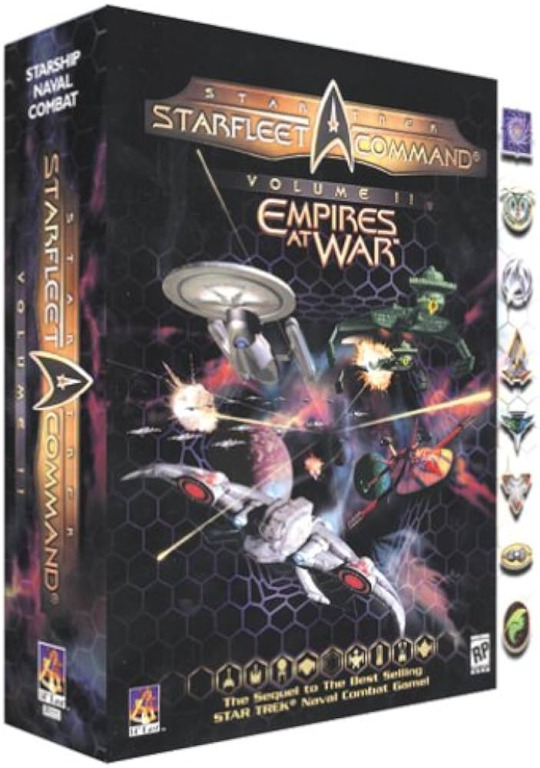
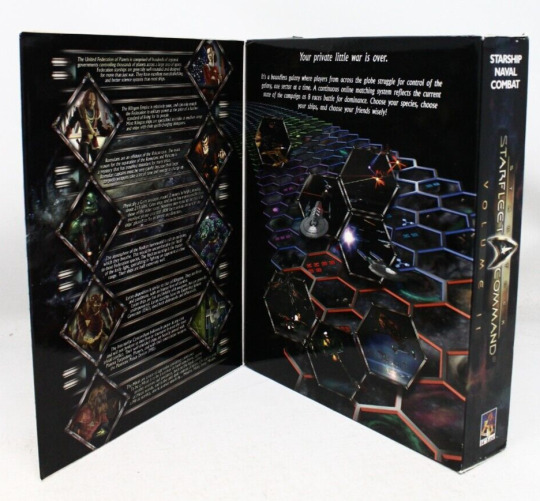
The game had a bad CD key and was unplayable. The dev had just gone defunct, so there was nobody to reach out to for support.
However, that game had a standalone expansion, so we ended up playing that instead.
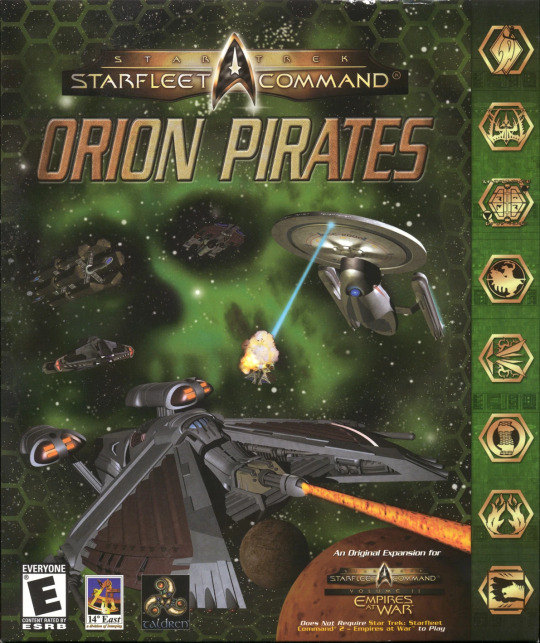
A game company’s crappy anti-piracy measure drove me to play the pirate game instead.
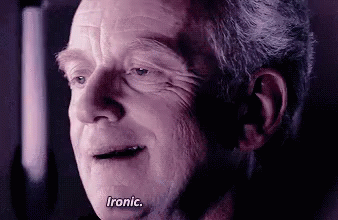
#star trek#star fleet battles#starfleet command#starfleet command ii: empires at war#starfleet command: orion pirates#orion pirates#pc gaming#anti piracy
2 notes
·
View notes
Text
Since spirk fanfiction is enjoying a moment, I offer these two bits of trivia about Kirk's past that writers may find useful:
In the TOS writer's bible, Gene Roddenberry wrote that prior to the Enterprise, Commander Kirk had been the skipper of a small destroyer-type vessel.
Vonda McIntyre, a prolific writer of licensed TOS novels for Pocket Books (including the novelizations of Star Trek II, III and IV) gave this ship a name, USS Lydia Sutherland. (It's not the name of a real person, out-of-universe it's a combination of two different ships commanded by Horatio Hornblower. In-universe, maybe she was some 22nd-century scientist or early Starfleet hero?)
#james t kirk#star trek#star trek fanfic#star trek the original series#the premise#star trek history
56 notes
·
View notes
Text
One of the other points Insurrection never gets enough credit for is that in a lot of ways, it really is the perfect test case for to what extent the Prime Directive should apply.
This is especially the case given how broadly it gets applied during The Next Generation. While in the original series, and to a lesser extent in Strange New Worlds, it's applied exclusively in the context of prewarp societies, the actual wording of the directive (as established in the animated series) is "No starship may interfere in the normal development of any alien life or society."
Why this applies to prewarp cultures is pretty clear cut. If they don't have the capability for interstellar travel, then they probably wouldn't ordinarily encounter alien life. Even governments other than the Federation seem to agree on this well enough that it's a near universal constant. Once they've achieved warp, it becomes inevitable that they'll encounter alien life eventually no matter what, so first contact is fine then.
During the TNG era, the Prime Directive also gets applied much more broadly. This is one of the reasons why The Hunted ended like that. It wasn't just that Angosia had to sort out its internal issues by itself before it could join the Federation; it's also a question of whether or not the Prime Directive would allow for Starfleet to be involved in what is an inarguable natural consequence of this society's recent previous decisions.
This is also one of the reasons why Admiral Shanthi was hesitant to give Picard a fleet at the start of Redemption Part II. The Klingon Civil War was an internal affair and a natural consequence of their issues with succession. It's only when Picard brought up the Romulan issue that it stopped being a purely internal affair.
So while this may not be how the Prime Directive got applied in previous times, it was how it was applied in TNG. Regardless of Dougherty saying the Prime Directive didn't apply, previous canonical precedent says maybe it is. Not only was this an internal dispute of a culture, in some ways it was quite literally a family feud between the Ba'ku and the Son'a given some of the Son'a were literally the Ba'ku's children.
While Dougherty wasn't commanding a starship when he got involved with this, the actual legal argument would probably go, "Sure, but this is clearly meant to apply to all Starfleet operations. That's how we've been applying it in practice for decades now." The actual sticking point on a legal level may have been whether or not the Ba'ku could be considered native to that planet. On a literal level, they weren't.
However, them being there didn't bring with it a lot of the issues real world colonialism did. As far as anyone knew, nobody had lived there prior to them, so they didn't commit genocide just to be there. They also didn't seem to have destroyed the local ecosystem, even in the three centuries they lived there.
What Dougherty and the Son'a planned on doing actually counts as genocide, though. This isn't just me going off to crazy town, either. The current legal definition of genocide, as per the UN website, means that deliberately inflicting on the group conditions of life calculated to bring about its physical destruction in whole or in part, which is what Dougherty and the Son'a were planning on doing to the Ba'ku, meets the legal definition.
I feel like this is something a lot of Insurrection's detractors tend to get caught up on. They'd like to do this very cynical moral calculus where getting rid of the Ba'ku was fine because the Federation was at war with the Dominion and the medicine they could extract from the rings could potentially save millions.
The trouble with that is twofold. Firstly, the calculus assumes the Son'a were right when they said they could do this. That's not guaranteed. Maybe they'd worked out how to make it work for themselves, but that didn't mean it'd work for anyone else and they'd just falsified the results. Maybe it didn't work at all and this was just a hail Mary attempt by the Son'a because they thought it was either this or extinction.
You also have to account for how the effects of the rings seem to kick in pretty quickly. The Enterprise's crew was there for a few days and they were already starting to see the effects. It's not really clear how long you'd have to be there for the effects to be permanent, but I doubt it'd be as long as the Son'a made it out to be.
Basically, a lot of this depends on taking the Son'a on face value even though they've been proven to not be completely honest, and even though they have every reason to have concealed more than just their heritage. Why would you buy into the sort of narrative they're setting up?
Secondly, whether or not it'd actually save that many lives depends a lot on where Insurrection fits in the timeline. That's not exactly clear, either. It's probably somewhere in DS9's final season, but which episode you'd put it near or between is ultimately just guesswork.
Personally, I tend to assume it probably happened during the events of It's Only A Paper Moon. That episode didn't feature Worf heavily, and it could have happened over the course of weeks or months, so it'd fit neatly without too much hassle.
Still, you know, that's not a given. It could have been further towards the end of the season, too. By that point, the war is much closer, and the "untold millions" the medicine derived from the rings--which still could be the pharmaceutical equivalent of vapourware, by the way--were much more limited.
So ultimately, I don't find the more cynical moral calculus the detractors bring all that convincing. It's based on a lot of assumptions that aren't necessarily in line with what happens in the movie itself, and are on shaky ground based on where the movie is in the broader arc of canon.
Even if you accept the premise that the Prime Directive is sometimes broken to secure the Federation's security, and that does have a lot more canonical credence, you still loop back to the cynical moral calculus problem. What specific security issue is the Federation having that it justifies the genocide of a people uninvolved in the Dominion War? If people in Starfleet correctly have issues with genociding the Founders, who actually are involved in the war, why shouldn't they also have issues with it here?
Anyway, as I was saying, the Ba'ku being on that planet doesn't have the same moral issues as real world colonisation brought. It's also accepted as a given that this is a thing that will happen. Even colonies that broke off from the Federation much more recently than the Ba'ku settled will be granted their independence and be allowed to operate with as much or as little input from them as they'd like.
So really, the question becomes even though the Ba'ku aren't biologically indigenous to the planet, when do they become culturally indigenous? That becomes a much murkier problem because of how these people are effectively immortal due to the effects of the rings. There isn't going to be the same sort of cultural drift from their original species, whoever they may have been, that you'd otherwise expect in three centuries.
Still, there would still be some. It'd be at a slower pace, but it'd be there. Given that the Ba'ku have been on that planet for nearly as long as humanity has had warp drive, their response to being told they aren't an indigenous culture to that planet would probably be something like, "We've been here since before you were able to get to the next system and back reliably. Who are you to lecture us on who belongs here?"
If you took the argument that because they weren't indigenous to the planet biologically to its logical conclusion, the Federation would have to forcibly retake all of its splinter colonies, too. While that's militarily viable with Ba'ku because it's only 600 people, that's not really going to be viable on Turkana IV, for example. You'd have to keep a heavy military presence there for decades, if not a century or more, for it to really work.
This is ultimately the kind of thing the Prime Directive is meant to prevent. Yeah, it is better for everyone who isn't the Federation if there is some legal limits to what it'll permit itself to do, but it's also better for them, too. Starfleet can bring so much power to bare in an instant that any precedent a rogue officer sets can potentially cause neverending problems for everyone else.
#rant#star trek#star trek tng#star trek the next generation#tng#the next generation#insurrection#star trek insurrection
12 notes
·
View notes
Text
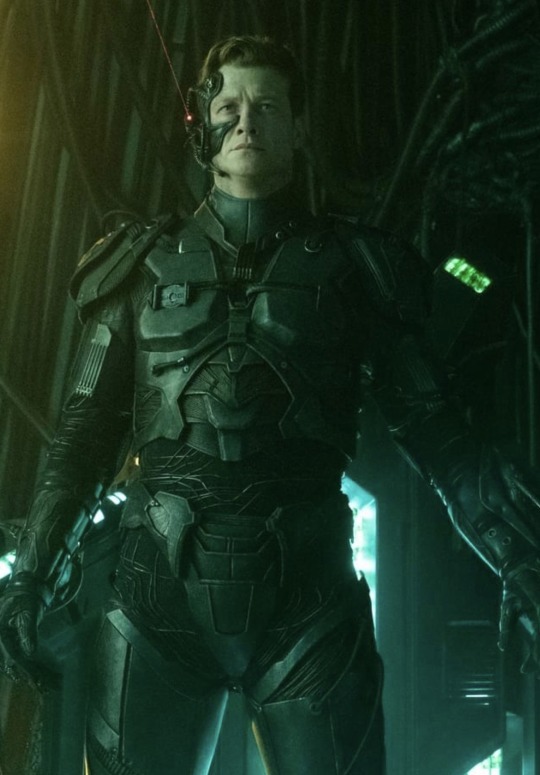
Lieutenant Commander Neal Bailey watched in horror as a forcefield materialized between him and the rest of his strike team. How the collective had managed to adapt to their saboteur efforts, he didn’t know. All Lt. Bailey knew was that the Borg had cut off his teammates’ only chance for escape.
“They must have rerouted power through to this section somehow!” Ensign Dan Korowsky exclaimed in dismay from the other side of the forcefield.
Standing next to him, Lieutenant Joe Cavalli, technician and resident Starfleet expert on the Borg, looked incredulous. “But we knocked out all the power generators routed through this section—and the regeneration nodes…” He lowered his phaser rifle and began scanning with his tricorder.
“We don’t have much time. Cavalli, can you run a bypass on this forcefield generator?” Commander Patrick Evans asked urgently. Cmdr. Evans, a decorated Starfleet Marine and the mission leader, looked around urgently for signs of pursuit. The mission had been going well—until now. Starfleet’s plan: insert a stealth team on frontier colony Ivor II, on the edge of the Klingon frontier. Objective: to determine if the Borg have destroyed the colony and its defense research facilities. Collect data, and if possible, neutralize any remaining cybernetic threat on the planet surface.
Within hours following their orbital drop, Cmdr. Evans’ team of five had successfully penetrated the former colony’s infrastructure. They found it almost completely assimilated by the Borg. Where once stood a joint human-Klingon venture in tactical cooperation, there was now instead a giant cube-shaped mass. Evans’ team penetrated the damp, humid structure, making selective use of explosives and computer overrides on entry. Now they were on their way out, having successfully downloaded data from several Borg distribution nodes. Oddly enough, at no time had they encountered any significant resistance.
“Let’s detonate it.” Ensign Mike Hunter, demolitionist and the youngest of their group, displayed his brashness yet again. But this time it seemed necessary.
“Fine…do it.” Cmdr. Evans agreed impatiently, wiping the sweat from his face. Ensign Hunter moved forward to attach photon charges around the corners of the forcefield projector frame. He had scarcely placed one charge on the floor when a whirring sound emanated from his immediate surroundings. The others heard it, but it was too late. Twin tubules, secreted within the framework of the forcefield, lanced out and plunged themselves into the young ensign’s neck, paralyzing him instantly. Ensign Hunter screamed in agony, falling to the floor. Lt. Cavalli fired at the Borg assimilation device, vaporizing it.
“Ensign!!!” Cmdr. Evans yelled in shock. Korowsky brought out his medkit and knelt beside his fallen teammate. Suddenly, klaxons sounded.
The team knew that the collective was afoot. In desperation, Bailey and Cavalli began firing at the forcefield from opposite sides. But it was no use. The Borg had awakened.
Drones materialized behind Evans and his team, and began advancing. Lt. Bailey could only watch as his teammates abandoned Ensign Hunter and began firing at the approaching Borg. One-by-one, drones fell. The team was at its best, wasting no shots. Within seconds, the Borg had adapted, but Evans’ team was prepared for this.
“Remodulate!” he ordered.
The team paused to activate their weapons controls, and resumed firing. Their weapons were effective once again, and the remaining Borg were mowed down. The complex was filled with an eerie silence. Evans, feeling relieved, turned to the still-active forcefield and the fallen Ensign Hunter beside it. The nanoprobes had done their work--the Ensign’s face had turned a pale shade of gray, and the telltale sign of Borg-colored veins and emerging implants were visible.
But before Evans could say a word, the sound of heavy metallic footsteps echoed again through the complex. The team braced itself for more drone beam-ins…but this time the Borg had a different strategy. In unison, two rows of Borg emerged from the corridor walls, forming two perfect flanks in front of the Starfleet team. They marched forward with incredible speed.
These were no ordinary Borg. Once, they had been the fittest of the humans and Klingons assigned to the base. Now, they were enhanced cybernetic warriors. Their already-impressive biological musculature had been enhanced beyond the ability of any other galactic power. These tactical drones did not carry conventional maintenance or surgical implements. Instead, they were built solely for combat assimilation. Sculpted armored plates conforming to their anatomically perfect cyborg bodies, made of Borg platinum and other enhanced synthetic alloys, moved with harmonious symmetry to their muscles. Interlocking plates across their thoracic sections provided an impenetrable barrier.
Ensign Cavalli was the closest and had the first shot. It glanced harmlessly off the Borg shielding. Cavalli remodulated, and fired again. The shot made a glancing blow off the lead Borg’s chest, leaving a cloud of plasma smoke. The rest of the team remodulated, and began firing.
But this time, the tactical drones emerged from the smoke, utterly unharmed. Their chest armor had absorbed the weapon impacts, and had in fact dispersed their energies back into their Borg power systems.
Evans watched in horror as his team’s weaponry was rendered utterly useless. Shot by shot, the Borg remained undeterred. The team switched to photon grenades. The first exploded in the center of the corridor, throwing the tactical drones to the sides. But it was not enough to destroy them. The Borg simply got back on their feet and marched forward.
The team had rehearsed what would happen if they were in a no-win situation. It was standard operating procedure for Starfleet’s elite strike forces. As the Borg drones reached within an arm’s distance, Evans dropped his weapon and reached for his belt where the emergency quantum grenade was stored. Better dead than assimilated!
“Lt. Bailey, save yourself!!” Evans ordered. On the other side of the forcefield, Bailey hesitated for a moment, then ran. The desperate but resolute look on his commander’s face was burned into his mind as he fled. Lt. Bailey ran down the corridor, and turned to see the explosion.
But it never happened…
The collective had learned all it needed. By accessing the mind of the drone formerly known as Ensign Mike Hunter, they knew the team’s plans. As Evans pulled out the quantum grenade, the prone form of Ensign Hunter suddenly came alive, and the newly assimilated Starfleet Marine charged into his former commanding officer, wrenching the device from his grip. With enhanced cybernetic strength, Hunter knocked Evans down with ease.
Before Lt. Cavalli or Ensign Korowsky had a chance to activate their self-destruct grenades, the tactical drones had surrounded them. Lt. Bailey watched from afar as they attempted to fight their way out, hand-to-hand. Their resistance was utterly futile. The Marines were knocked down, one-by-one. One drone took particular pleasure in testing his growing cybernetic strength against the humans. This newest Borg drone had gone from the archaic designation of Ensign Michael J. Hunter, Starfleet service #11283-5496 Alpha, to the efficient label of One of Five, primary subunit of Tactical Trimatrix 315. Resistance was utterly futile.
Ensign Korowsky found himself separated from the others. He’d been knocked unconscious in the scuffle, and now found himself attached to an assimilation table. A tall, muscular six feet and 200 lbs. of muscle, Korowsky prided himself on being able to master the machinery around him—and to use strength to win any situation. It was an attitude which had gotten him very far in the Starfleet Marines. But now his human strength was no match for the assimilation table’s restraints.
Korowsky wondered why they hadn’t assimilated him already. He felt no different, aside from a splitting headache from when the drones had struck him down. He felt no burning sensation in his bloodstream or puncture wounds on his neck or elsewhere. Korowsky realized, with a sinking feeling, that he was only waiting for the inevitable.
A soft breeze wafted through the assimilation chamber, making the Ensign’s body hair stand on end. It was then that Korowsky realized that he was completely stripped of clothing. In the incredible humidity of the Borg complex, he hadn’t noticed. Could it be that the assimilation chamber was even hotter? Around Korowsky, the cacophony of power conduits and throbbing regeneration alcoves echoed.
The walls in front of him shifted. A Borg drone approached. This tactical drone was of the same unique configuration that the team had encountered moments before they were captured. It was apparent that this particular unit had once been a very young, attractive-looking human male. He was tall, and muscular, with handsome features that were augmented by cranial tubing and implants but no ocular eyepiece. The drone had large, piercing green eyes, and his face bore the expression of a slight superior sneer. His body was covered from the neck down with thick Borg platinum armor which wrapped tightly around his bodybuilder physique. Was this one of the former colonists?
“We are the Borg. Your biological distinctiveness will adapt to service us. Resistance is Futile,” the drone intoned in a deep, synthetic voice. As the drone approached, Korowsky closed his eyes and clenched his square jaw in anticipation of the pain.
The drone reached out with one arm for Korowsky ’s crotch. Assimilation tubules shot out from his fingers, and plunged deep into the base of Korowsky’s penile shaft. The Starfleet Marine screamed in pain…
Seconds later, breathless, Korowsky opened his eyes in bewilderment. He felt a change—but it was not the assimilation that he had steeled himself for. Instead, he had felt himself get incredibly aroused. He was powerless to stop it—his cock lifted up, up into a raging erection. He was harder than he had ever been in his life. Korowsky arched his back as far as the assimilation table would allow and gasped in surprise and pleasure as his cock swelled with blood and stretched to its limit.
The assimilation table began to swivel, and brought Korowsky up to a vertical position. Then, with the drone standing behind him, the restraints released, leaving Korowsky standing with a massive erection.
“You represent a team which Starfleet selected to be on the front lines and infiltrate the Borg. Your combat skills and physical ability indicate that you are an excellent specimen of your species. Your genetic distinctiveness will become our own.”
Korowsky was unrestrained, and seemingly free to go. But the force of his erection was too much. The Ensign groaned as he felt his tool begin a change. The nanoprobes in his bloodstream were designed for assimilation, but they could also provide simply augmentation. That was exactly what Korowsky was experiencing as his testicles began to swell and grow heavy. He could feel the semen flooding through his reproductive tract at an alarming rate. He felt his body tighten up as the fluid rushed forth in a torrent up his shaft, and yet he did not ejaculate.
Instead, Korowsky stood there, his brain functions overcome with the hardness, the tension. The air around his naked body seemed electrified with sexual possibility. His whole being was collecting around his cock. It was unbearable; he felt primed to explode.
Korowsky groaned with pleasure as he felt his cock stretch even further. The cybernetic augmentations had grown his tool to massive proportions!
In the humid heat, with wave upon wave of energy seemingly directed at his mind, Korowsky felt the collective speak to him. The drone seemed to whisper…
Service the collective. Provide your biological distinctiveness to us.
The space ahead of him was dominated by a column-shaped alcove which reached through the ceiling. Korowsky felt compelled to move toward it, and he did. As he walked, his shaft began dripping pre-ejaculate; his cock was filled to bursting with cum.
When he finally stood in the alcove, his mind awash with the burning sensation of pre-orgasm, Korowsky thrust his hips forward into the orifice, which resembled a power socket. As he did, he felt a sense of relief. The regenerative Borg technology molded itself around his cock, gripping it tightly. Then, the alcove sprang to life, with power flowing through conduits and into Korowsky ’s body. The Starfleet ensign felt the sensation of a thousand fingers stroking his cock, licking it, sucking it—all synthetically, of course. He gasped, and his cock finally exploded.
Korowsky shuddered as his cock began releasing its juice into the alcove. He was in ecstasy, and it was never-ending. The alcove continued accepting his seed, and Korowsky, plugged in and nanoprobe-enhanced, kept pumping away. Sparks of electricity raced up and down the alcove and through the Marine’s body, overwhelming his senses.
As the minutes and hours passed by, Korowsky’s face assumed an expression of delightful agony, his jaw clenched in instinctive seriousness as his body shot its seed repeatedly. The torrent of cum was never-ending, as the alcove continually fed nutrients to sped up bioproduction in Korowsky’s body. As time went on, more and more nanoprobes entered Korowsky ’s system, slowly assimilating him, yet leaving his genitals enhanced but unassimilated—for now.
No human was ever made to have an interminable orgasm. But the Borg could do what evolution could not. Korowsky was the first, but certainly not the last to undergo this enhancement. As one orgasmic cycle ended, leaving the alcove full of liters of ejaculate, Korowsky gasped for breath, his hips relaxing for a moment.
Within seconds, the alcove socket clenched Korowsky’s rock-hard cock again, and he shuddered. The Starfleet marine could only grab both sides of the alcove and hold on for dear life as his permanently hard cock continued pumping away.
Behind Korowsky, the tactical drone watched impassively. But as the first Borg implants emerged on Korowsky’s skull, the drone seemed to smile. Or was it envy?
The pleasure seemed to last an eternity. But as the collective’s appetite for Korowsky’s seed was sated, it was replaced with their need to add individual distinctiveness to their hive. Organ by organ, inch by inch, the nanoprobes assimilated their way through the Marine’s body, eventually reaching his head and finally activating their assimilation programming in his cock. The last of the human personality known as Dan Korowsky faded into an orgasmic howl as Two of Five, secondary subunit of Tactical Trimatrix 315, was born.
Lieutenant Joe Cavalli awoke in another assimilation chamber. He was also bound, naked, to an assimilation table. Cavalli felt his heart pounding—he’d gone over this situation countless times in his years of research into the Borg collective. And yet he still did not fully understand the exact nature of the assimilation experience. After all, few eyewitness accounts existed. Nearly all who had seen the process were either dead or members of the collective themselves. Cavalli expected the same fate.
Yet he would not have expected the appearance of another tactical drone before him. Starfleet had no records of this type of drone—there was truly so much that they did not know about the collective. The drone had large, piercing green eyes, and it spoke to him in a synthetic yet masculine tone.
“You will provide your knowledge and expertise of Starfleet tactics against the collective to us.”
Before Cavalli had a chance to answer, the drone had leapt up onto the assimilation table, displaying impressive agility, and was straddling his body. Cavalli felt the incredible heat emanating from the drone’s body as it slid across his body, finding his cock. The drone looked into Cavalli’s eyes and gave a seeming half-smile, then grasped at Cavalli’s cock.
Part of the Starfleet Marine was repulsed and yet at the same time he felt strangely aroused. Perhaps it was pheromone-induced? As Cavalli pondered this fact, his mind struggled to resist the sensations but his body betrayed him. Cavalli felt his cock stiffen and almost immediately the moist warmth of the tactical drone’s mouth slipped around his cock and began sucking expertly. Cavalli felt a wave of pleasure come over him.
It was unlike any sexual experience he’d ever had. The instant his cock entered the drone’s mouth, he could hear sounds of the collective. A massive, synchronous voice filled his head. Cavalli gasped as hive mind commanded him to obey.
He struggled to break free of the control but the power of one mind was insignificant compared to the might of the collective.
"No…I…my duty is to Starfleet, the Federation…I am a Starfleet officer—
"I…will resist!!!!" This mental assimilation quickly became a war of wills, of biology versus technology.
"I will resist….my duty is to…." then Cavalli gasped as the drone released him. The withdrawal of the voice drained him greatly—it was like a narcotic. The collective was massive, powerful, dominating…Cavalli felt himself long to surrender to it.
The drone looked at Cavalli as if assessing his worth, then continued the process. He moved forward, sitting on Cavalli’s chest, and let his massive Borg cock rest on the Starfleet Marine’s face. With a firm but gentle push, Cavalli’s mouth was opened and the cybernetic shaft entered into him. The Borg cock was completely rigid, and coated with metal. Yet it was surprisingly warm.
When the cock entered Cavalli’s mouth, his whole awareness was transformed. He felt the collective in him and around him.
"I am the---I—I will resist…must resist…must----Resistance is Futile. My duty is to Star—My duty is to the collective. I am Joe Cavalli…of Borg. My designation is Three of Five, secondary processor of Unimatrix 315. I will—we will provide all tactical knowledge to the collective. This unit will service the collective."
By now, the primary programming was complete. This human would not resist any further mental extraction efforts. His mind was open and part of the collective. Before the Borg had integrated Cavalli’s biological distinctiveness into their own, they had already converted his psychological distinctiveness into the beginnings of Borg algorithms. Phase one of assimilation was complete.
Cavalli did not resist as the tactical drone impaled him with his cock, and simultaneously plunged his assimilation tubules into his neck. Phase two of assimilation had begun.
Lieutenant Commander Neal Bailey had endured a most painful two hours alone on the outskirts of the former colony. He’d witnessed all of his teammates being captured by the Borg. He could only assume that they’d been assimilated or killed. He hoped it was the latter.
The mission had failed miserably. With Lt. Cavalli’s capture and Ensign Hunter’s assimilation, all their reconnaissance data had been lost. Their remodulated weapons, which ordinary Borg couldn’t adapt to, had no effect on these new tactical drones. Now Lt. Cmdr. Bailey found himself alone.
But he just couldn’t accept the loss of his teammates. They’d been together on more missions than he could count. Each team member had saved the others on numerous occasions. Bailey owed it to each man to do everything possible to rescue them.
For the past two hours, Bailey had searched the Borg complex's walls, trying to find a way in. When the team first arrived, the colony had numerous entrances. Now every last one was sealed by a forcefield. After seemingly endless searching, the Starfleet Marine had resigned himself to returning to his exit point and resorting to tricorder scans. Meanwhile, the Borg complex stood impassively, glowing with the power of alcoves, conduits, and power systems coming online, one-by-one.
With a brief flicker, the forcefield closest to Bailey went down. The Marine stood up. Did the Borg consider the threat over? Grabbing his weapon, Bailey walked into the complex, scanning all the way.
As he entered the Borg facility, Bailey saw maintenance drones working alone or in pairs at various stations throughout. They seemed to be engaged in construction activities which served to expand the Borg facility. There was no opposition of any kind, and no Borg tactical drones to deal with. As Bailey moved deeper into the complex, retracing his steps, he found several forcefields down and not others. Scanning the layout, Bailey was confounded by the seemingly random placement of chambers and equipment. Was he being led somewhere?
Ahead, Bailey saw a Borg chamber with a series of tall columns on aligned near the walls. In the center was an assimilation table. And on it--one of his teammates. Bailey rushed forward, and saw who it was.
“Commander?” he asked breathlessly. Aside from some bruises on his face and neck, the team leader looked unscathed. Bailey leaned over the assimilation table, searching for signs of life.
The Commander’s eyes opened.
“You came…just in time,” Cmdr. Evans said.
“Sir, I’ll get you out of here!” Bailey responded, and began looking frantically for the table’s controls.
“There’s no need,” Evans replied. And Bailey froze to look at his former Commander. The bruises on his neck reformed, and the telltale signs of assimilation became visible. Evans had been assimilated just moments before. Bailey turned in horror, but Evans reached up and grabbed his neck.
“Resistance is futile, Bailey…once you’re with us, you’ll understand.”
“Never!!!” Bailey replied, turning to escape. But out of the shadows, four tactical drones emerged. One was the former Joe Cavalli, another used to be Mike Hunter, the third was once Dan Kawalsky, and the last, with piercing green eyes, he’d never seen before. Only his comrade's faces were recognizable now, behind the Borg flesh and tubules; their bodies were taller and stronger, with massive, rippling muscles and thick armor.
Resistance is Futile, the tactical drones intoned in unison, and began moving forward. Bailey lifted his rifle and opened fire at point-blank range. This time, Borg energy shielding protected the drones from any damage.
Just as the drones closed around him, Bailey saw out of the corner of his eye Cavalli’s armored suit and rifle placed on a Borg examination table. The collective had added the Marines' technological distinctiveness already…
The drones pushed Bailey to the ground and were on top of him instantly. Bailey felt the crushing weight of the massive, newly-born tactical drones as they grabbed at his body and tore off his suit. The Marine struggled in vain. Even his most violent thrashing was unable to prevent an assimilation tubule pinprick, precisely positioned at the base of his crotch. Within seconds Bailey was fully aroused. Two of Five instantly took Bailey’s tool into his mouth; Three of Five inserted his cybernetically-enhanced rod into Bailey’s mouth, and the other two drones were lifting Bailey on to the assimilation table…
Bailey surrendered to cybernetic bliss…within 55 minutes the last member of the Starfleet strike team was gone, and Five of Five, tertiary subunit of Tactical Trimatrix 315, was born…
Hours later, a tactical drone led five new assimilation warriors to a newly-completed regeneration chamber. There, Tactical Trimatrix 315 entered Borg alcoves for the first time. The hive was now fully satisfied. All targeted assimilation…complete.
229 notes
·
View notes
Text
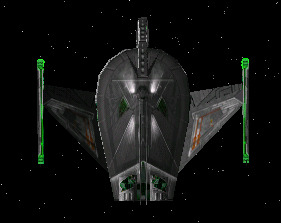
Romulan Bird of Prey (refit) from Starfleet Command Volume II, 2001.
8 notes
·
View notes
Text
an-artsy-girl000 replied to this post (but presumably actually this one):
Decker was asbolutely in the right. The good thing about this movie is that it never tries to make Decker into the obnoxious villain you paint him out to be. He's hurt, yes. But he's always making rational decisions and never panicking. Kirk is also partly right- he is definitely more experienced than Decker. But he doesn't know the ship anymore. He's driven by his ego, more than Decker is, but even then, he knows when to admit someone else was right. All that to say, Decker and Kirk are super well written. Neither is perfect, and that's why their characterization is so fucking good
I nowhere said nor meant that Decker is a villain, though yes, I do think his behavior is deeply obnoxious and short-sighted long past the point when it's justifiable. Villainy would be trying to get Earth's population wiped out on purpose. Decker merely recommends an approach to the V'ger crisis (over and over and over, even after Spock's arrival) that would unintentionally have that result, which is less competent than doing it on purpose but definitely not villainous.
His conduct as first officer is additionally unprofessional and petty, but as I also said, I think that is a much smaller issue than his relative weakness as a tactician. I firmly believe that Decker is unqualified for full command of this particular mission, all the more given the number of lives at stake and his own tactical recommendations throughout the mission. That doesn't mean he's unqualified to command any mission, or that he's secretly malevolent, he's just not the guy for this job.
And the thing is, given the stakes set up by the plot of TMP, this is not really a situation where you can split the baby. After the early refits learning curve (which Decker is not uniquely qualified to assist with), his ongoing recommendations would have been disastrous for billions of people had Kirk followed them. Like, either—
a) these recommendations are not what Decker actually thinks should be done. Had he retained command, he would have made the kinds of decisions Kirk does in TMP that allow for even the possibility of success, in which case his contrary advice as first officer is wildly unprofessional at the worst conceivable time, or
b) he's actually being honest about thinking slow and cautious tactics are the way to deal with the V'ger crisis, in which case he's a deeply inferior commander for this specific mission, and it was for the best that Starfleet placed the survival of Earth's population in the hands of someone more experienced, gifted, and decisive (clearly indicated by Uhura's chiding remark about how Kirk receiving command had doubled their chances of success).
Either way, Decker's wrong in the circumstances. Yeah, it sucked for him personally, and yes, he was right about a few specific orders early on, but I think he's absolutely wrong in the big-picture sense that matters a lot more. There are just far more important things going on during all this than him being mildly screwed over, and he doesn't seem to recognize the urgency or priority of those in the way that Kirk, Uhura, and eventually Spock do.
Also, we have even deeper disagreements if you think Decker is that well-written. The writing of him isn't godawful, but I don't think it's anything like good, much less super good. If anything, I think the script is probably more unkind to Decker and Ilia than any other major characters, to a degree that feels unfair. IMO pretty much all the best dialogue in TMP goes to Spock or Kirk, and even with them, there's a lot that's carried by Nimoy's and Shatner's performances far more than the writing, as well as by the audience already more or less knowing them.
I think Decker's and Ilia's dialogue in TMP is mediocre, not helped by so much of their characterization and motives getting lost in the shuffle from Phase II to TMP (even the conflict between Kirk and Decker is mainly an artifact of late reshuffling; Decker had been envisioned as a personable first officer who idolizes Kirk almost as a father while Kirk is deliberately grooming him for command). And Decker's actor in particular does not have the screen presence to elevate the dubious writing the way that Nimoy and Shatner do in TMP, or Frakes and Sirtis in TNG for that matter. Riker and Troi are obviously much-improved second drafts of Decker and Ilia but still suffer from plenty of bad writing, yet the actors bring a ton of warmth and charm to the characters in a way that I don't think succeeds in TMP.
#really unsure what about posts labeled 'willard decker critical' have been pushing decker apologists out of the woodwork but...#well. uh. nah.#respuestas#an artsy girl000#c: who do i have to be#long post#st fanwank#willard decker critical#star peace#tmp critical#(apparently my REALLY disruptive opinion is that tmp has major writing issues! there are definitely scenes where i'm like#i don't like feeling bad for william shatner but he is carrying everything right now. maybe if decker were better written#or the performance was just really really good... but no)
8 notes
·
View notes
Text
While this ranks relatively low on my overall list of complaints about STAR TREK: DISCOVERY and STRANGE NEW WORLDS, something I find annoying about them is that they've really built up the size and strength of Starfleet to something closer to what it is in STAR TREK: THE NEXT GENERATION, which contradicts TOS in ways that have far-reaching story effects.
TOS repeatedly indicates that in that period Starfleet has only a handful of ships in the Enterprise's class, presumably because they're resource-intensive to build and operate. As Kirk and John Christopher discuss in "Tomorrow Is Yesterday":
CHRISTOPHER: Must have taken quite a lot to build a ship like this. KIRK: There are only twelve like it in the fleet.
That plainly doesn't mean that Starfleet has no other ships, but ships of what TOS describes as the "Starship" class ("Constitution-class" is a later coinage) are uniquely capable. As Merik, former commander of the SS Beagle, explains in "Bread and Circuses":
MERIK: He commands not just a spaceship, Proconsul, but a starship. A very special vessel and crew. I tried for such a command.
This special status is a central part of the premise of TOS: It's the reason why the Enterprise is assigned such a diverse array of duties, and why what the Enterprise does is so important to the plot. Even into the TOS cast movie era, we're frequently told that the Enterprise is the only ship in the sector capable of responding to a problem or threat, and the crew is rarely in a position to call for reinforcements even where that would be tactically or strategically advisable.
While that makes duty on one of these ships very risky (as evidenced by the number of the Enterprise's sister ships that are lost with all hands in TOS, including Constellation, Defiant, and Exeter), as Merik's remark indicates, it's also a plum assignment, and one for which there's obviously fierce competition. The TOS bible makes much of the fact that Kirk is the youngest person ever to command one of these starships, and he also appears to be one of the lowest-ranking. (Many of the other starship captains we see are fleet captains or commodores, as well as being older than Kirk.) This comes into play at a variety of points: For instance, it's at the root of Ben Finney's animosity toward Kirk in "Court Martial" (and presumably why Kirk's peers are quick to give him the cold shoulder when he's charged with negligence in Finney's apparent death), and it's part of the tension in "The Doomsday Machine," where Kirk and Spock have to maneuver around the fact that Matt Decker outranks Kirk and is clearly the senior officer.
The limited number of starships also provides a useful Watsonian explanation for the dichotomy of a capital warship (which the Enterprise unequivocally is) being used for scientific research and exploration missions. Although TOS is reluctant to say much about civilian life within the Federation, we can probably assume that such costly starships are the subject of a lot of political wrangling, and the different roles the Enterprise plays probably reflect those tensions: The Enterprise's scientific duties may be a concession to those who (like David Marcus in STAR TREK II) are wary of Starfleet's military role, and perhaps an effort to extract a greater civilian return on the Federation's obviously substantial military investment. It might also be a diplomatic ploy, or an attempt to maneuver around arms control treaties with rival powers like the Klingons and Romulans. (Arms-limitation treaties are probably the most plausible explanation for the Enterprise-A being so hastily decommissioned and its entire class apparently being mothballed shortly after STAR TREK VI.)
DISCOVERY and STRANGE NEW WORLDS pay lip service to the specialness of ships of the Enterprise's class while undermining the point by indicating that Starfleet also has hundreds if not thousands of other, slightly smaller starships with 80 or 90 percent of the Enterprise's capabilities, carrying out a similar range of missions. I can see why they've gone that way, and there's obvious precedent for it in the TOS cast movies, which depict several other classes of Starfleet ships, but interposing that into the TOS era inevitably weakens the premise of the original stories, and renders many of the conceits of TOS unintelligible. (If it were up to me, I would attribute the expanded range of ships to changes between TOS and the era of the movies, which are set years later and have different narrative priorities.)
This retroactive Starfleet expansion also exacerbates the increasingly jingoistic militarism of modern STAR TREK, which is uncomfortably pronounced in both the Abrams films (which got money from the Pentagon for it) and in the recent shows (which I suspect are also getting DOD money, although I haven't seen that specifically confirmed). The large-scale fleet maneuvers of the finale of PICARD, for instance, are frankly terrifying, and would be even without the contrivances of the plot. A Federation that celebrates "Frontier Day" with a massive display of military power within the solar system, obviously aimed at awing and intimidating citizen and adversary alike, seems like a pretty harrowing "post-scarcity socialist utopia," even by the standards of a show that's always been about the crews of a spacegoing navy doing interstellar colonialism.
110 notes
·
View notes
Text
Star Trek history...

Number One has a word with Captain Pike.
Majel Barrett played the character "Number One", First Officer of the starship Enterprise in the 1965 first Star Trek pilot "The Cage". Alas, that would be the only time we'd see Number One (no name ever given) back in the classic era. Legend has it that NBC was uncomfortable with a woman in such a position of authority so the character was dropped for the second pilot "Where No Man Has Gone Before". Barrett didn't appear in the second pilot but when Star Trek was ordered to series she returned to the cast as Nurse Christine Chapel.


She reprised that role in the original cast feature films becoming Doctor Chapel in Star Trek: The Motion Picture...

... and later rising to Commander and served as Chief Medical officer on the USS Excelsior.

Later, Barrett played the sometimes bonkers and sometimes tragic Lwaxana Troi, mother of Deanna Troi, Daughter of the Fifth House, Holder of the Sacred Chalice of Riix, Heir to the Holy Rings of Betazed, appearing in Star Trek: The Next Generation and Star Trek: Deep Space Nine.

Barrett also provided the voice of Starfleet computers. The voice was heavily distorted and mechanical in the original series, but sounded natural from Star Trek: The Next Generation on, continuing through the Voyager era and speaking one word in the Star Trek: Enterprise episode "In A Mirror Darkly: Part II".

Her final performance both as the computer voice and as an active participant in a Star Trek production was in the 2009 reboot film Star Trek. Some of her archived material was used in Picard season 3 after her death.
In many ways, Majel Barrett is the grand lady of Star Trek.

27 notes
·
View notes
Text
Okay. After like 3 years I’m finally posting that essay on leadership in the pilot episode of Star Trek Voyager that was a term paper for me during college. I was very hesitant to post and still am not due to quality, but out of sheer caution in regards to plagiarism software used in education nowadays. So PLEASE DO NOT COPY FOR BOTH OF OUR SAKES.
Thankfully, I am graduated now, so I have less resignations on the topic (but it is still in the plaigerism testing systems, so please don’t copy it, mostly for your own sake in academic writing).
It’s probably boring to a lot of people, but for anyone who wants to read it here you go.
A “Voyage” in Leadership
Wc: 3080
I. Introduction
“Space the final frontier”; these are the words that have been imprinted on viewers by the not so subtle branding of Star Trek (Star Trek,1966). While the original series surged television screens in the 60s, the 90s were flooded with a revitalization of the pop culture phenomenon. Until Voyager aired, the series that preceded it, like Next Generation, were very formulaic; they took place in known regions and dealt with pre-established alien species and conflicts. Voyager in its nature broke the mold by instating Star Trek’s first female captain and brought Trek to new heights with new moral dilemmas. The series takes the Voyager ship away from all command structures the crew has ever known. They have to make every choice and decision with little guidance but each other. Star Trek has always been about exploration and when referencing Voyager with that same lens, that exploration also applies to people. Each individual aboard this journey makes decisions that impact who they are as leaders and followers, some like Voyagers captain, Janeway, demonstrate several healthy leadership qualities, where others are just getting their footing in their leadership journeys. Within this paper I will be diving into the depth of Captain Janeway as a leader, the forming of the Voyager crew, and small choices the individuals make which define their character.
II. Description
The Maquis, a rebel group to the Federation, are sent through a shock wave to the other side of the galaxy, 70,000 light years from the solar system. Captain Katherine Janeway is sent on a mission to track down the Maquis ship. This mission includes standard starfleet personnel and the addition of Tom Paris, ex- Maquis doing time at a Starfleet Penal Settlement. En route to Voyager, Tom, meets fresh out of the academy, Harry Kim. Despite only just meeting Kim, Paris saves him from getting caught up in foreign schemes. We are introduced to the show’s namesake via Paris and Kim making their rounds checking in with the less than personable head of medical, the similar first officer, and finally a non-judgmental individual, Captain Janeway, as the ship disembarks on their journey. The same phenomena that launched the Maquis ship 75 years away, launches Voyager to the same location as the Maquis, each with substantial damage. Janeway leaves her position on the bridge to go and aid engineering in repairs. The entirety of the crew gets transported to the array, the ship of The Caretaker, which sourced the anomaly that brought them to the other end of the galaxy, also known as the Delta quadrant. They all awake three days later, each crew missing 1 person. For Voyager, that person was Harry Kim. Janeway and Chakotay, the Maquis leader, unite and join forces in hopes of finding their crew mates. Paris becomes especially upset at the loss of Kim. Kes, a local, informs them that Kim is with her species the Ocampa, a cave dwelling group. The Ocampa have been cared after by the Caretaker for generations. Kim attempts to escape to the surface and by the time the rescue team make it to the Ocampa, he had already left. With the Caretaker beginning to collapse the cave exits, the rescue team escapes to the surface, but not before Chakotay gets trapped and Paris goes back to help him. Upon returning to their respective ships, the Kazon, a local gang-like race, begin attacking Voyager in attempts to attain its technology whilst the Maquis ship holds them off so Janeway can speak to the Caretaker to send them back to the Alpha Quadrant, where Earth is and where they all began their journey. What Janeway discovers is that the Caretaker is dying and that he plans on self-destructing the array so the Kazon can't use it against the Ocampa. Before he gets the chance to, he dies. Janeway makes the decision to destroy the array to save the Ocampa thus truly stranding them all in the Delta Quadrant (Berman, 1995). The captain of Voyager is the epitome of the ideal leader, her followers are her crew, and her situation is nothing less than complex and ever changing as she must “navigate the ambiguity” within (Wheatley, 1999).
III. Group Formation and Interactions
Although Janeway had never met Paris before, she is immediately very personable in their conversation and establishes a connection before even attempting to recruit Paris to join her team (Akin, 2020). She references working with his father before becoming a captain, and in the novel, Voyager: Mosaic, Tom’s father was the one who pushed Janeway to pursue command because of her strong leadership (Taylor, 1996). Tom and Janeway’s relationship immediately develops into one of familiarity and becomes strong with their commonality, which makes Tom feel more comfortable with his decision to go through with the deal to join Janeway on this mission. Janeway also eased the decision by providing Paris with a reward. Janeway is quite smart about this encounter because she lets him make the decision on his own and does not punish him if he chooses to not go through with it; it is clear she is using a variety of influence tactics in this conversation, like rational persuasion, personal appeals, exchange, and apprising, to get her goal accomplished (Curphy et al., 2014).
Paris meets Kim in a compromising position of blatant racism, but knows he is younger and less experienced in the ways of the galaxy, so before their introduction, Paris in fact saves Kim from danger of which, in the novelization, includes Kim thinking to himself: “I’ll never be that cool” in reference to Paris, putting him on some sort of pedestal early on in their relationship (Graf, 1995). The chief of medical and the first officer are put off by Paris because of his criminal record, that his new friend, Kim, still is unaware of. These crewmembers that they encounter are understandable in their attitude toward Paris given his past, but they each fail to recognize he is there on his own accord; they are still in the Newtonian mindset where they understand the individual parts, but fail to grasp the total situation (FOWLETT). Kim confronts Paris about his misdeeds and says, “I don't need anyone to choose my friends for me” (Berman, 1995). Their relationship is already so strong from this comment. Paris also notes that he took full responsibility for his actions involving his time with the Maquis, increasing the characters overall trust we as viewers give him (Akin, 2020). Though he was put in a penal colony for the actions, he still has the trust of those in authority, which is why he was chosen for this mission and Janeway knows he has potential to grow and get past that part of his history. Later in the episode, Paris is the one who notices Kim isn’t on Voyager .“The writers put a lot into their relationship being developed” actors Robert Duncan McNeil and Garrett Wang note, who play Tom Paris and Harry Kim respectively (McNeil, Wang, 2020). Down on the planet, Kim and the stolen Maquis crewman get to know one another in captivity; despite their different backgrounds, they try to understand their situation together and become mutual allies because of their situation. This demonstration of the group forming process is what leads them to team up and eventually escape back to their ships (McNutt et al., 2004).
IV. Captain Janeway as a Leader
Janeway takes everything she is dealt one moment at a time, although she has more than one thing on her plate at a given time in the episode, she somehow manages to keep things in order to deal with each one to the best of her ability individually and not get distracted. While Janeway is not always perfect, she is a prime example of good leadership in practice. Janeway has a great understanding of her duty as a manager which allows her to cope with the natural complexities of commanding a starship. If she needs things done a specific way, she is tactful and organized, but ends up getting her followers motivated to get things done (Kotter as cited in Wren).
When Paris and Kim finally meet Janeway for the first time in her ready room, Kim is even more stressed than meeting other members of the ship. Janeway sees this panic in his behavior and puts him at ease, but keeps the situation formal as she is still the captain. Janeway knows what she wants and how she wants it done; she uses precision and accuracy to deliver her message of trust to Kim. Janeway is a very adaptive kind of leader. Everything she does is a causality of what is occurring around her; she is constantly looking at the bigger picture and highlighting areas where problems occur (Grashow et al., 2009).
Janeway stays as level-headed as she can in the distress of her damaged ship, but is forceful getting things accomplished. She recognizes that many of her crew have died and she still remains calm, not allowing herself to mourn them until the ship is in a more stable position (Akin, 2020). Janeway leaves the bridge in the hands of the remaining crew there and trusts they know what they are doing and to continue performing admirably with her absence as she goes to assess and command in engineering, where she is more urgently needed(Akin, 2020).
When Janeway arrives in Engineering she provides insight and guides them to a solution to fixing the ship, but she still leaves the duty of actually fixing, to the crewmen. Janeway took control and got them on to a problem solving path and then let them fix it in the end, even though she could have (Akin, 2020).
Janeway is adamant about getting onemember of her crew and a member of her enemy’s crew back; Janeway shows remorse and declares she needs to get to know who her crew really is in order to get them home. This moment is very thought out as she has actively demonstrated her urge to create connections with everyone she meets, but because she has lost Kim, she is doubting herself; in this moment, her feminine attributes could be a downfall, but overall it allows her to care for her crew like they are family (Beggan et al., 2004). In her nature, being a female also influences her leadership style; she reaches out to crew members in time of her own struggle despite her being higher up in the chain of command than them (Beggan et al., 2004). In this moment of self-reflection, her security officer says, “The crew will not benefit from the leadership of an exhausted captain” and she snaps out of her head to get back on track (Berman, 1995).She knows that if she is to be successful in saving Kim, capturing the Maquis, or even getting them all home, she needs to detach her strong emotions, but remain connected to the tasks at hand and she has that switch in her brain accessible, not letting the sociology define her leadership too much (Beggan et al., 2004). As noted in the Leadership Encyclopedia, women tend to be more democratic and throughout this episode she is constantly aiding a variety of people of which in return she receives input and counsel from them without asking for it (Beggan et al., 2004).
Captain Janeway makes all of the crucial decisions away from her higher ups. No one can dispute her except her followers, and they don’t, in this grand decision to travel back to the Alpha Quadrant the long way home because they have trust in their leader. Janeway essentially breaks down the barrier of what is normal and from this point further, the ship is unlike any other in Star Trek history. The crew of the Enterprise and Deep Space 9 were all very close, but Voyager became a family. Janeway made sure that even she got to know every crew member(Gabriel 2018). Janeway is noted throughout various forms of Trek media for her leadership. From her interactions with individuals, knowledge of when to put on her manager hat v. her leader one, to tactics in influence and delegation.
V. Other Leadership Demonstrated
In servant leadership, an individual leads by serving others, meaning they are not necessarily the one in command of a situation, but they lead themselves as being part of the followers . Tom makes a daring move when Chakotay gets stuck in one of the tunnels; he returns to help him escape. While each still having residual feuds from Tom betraying the Maquis by working with Starfleet, this brave example of servant leadership does not go amiss. While servant leadership general doesn’t include risk of bodily harm, Tom uses it as such, he had learned from earlier in the episode he had to initiate things for himself and in this he chooses to risk his own safety to serve the goal he had made for himself, “the invisible leader”(Northouse, 2019). In this same scenario, even in the face of death, Chakotay’s leadership style is in full display as he tries to command a situation he is not in command of; he virtually argues with Tom the entire time he is saving his life and is a clear display that authority is a personality trait for him. Tom has grown from the first time we see him in this episode to this point; in the beginning he was very the follower that required the use of several motivation tactics to get work out of, but at this moment he has learned that his growth as a person is stemming from not necessarily being in command of a position, but serving those in those positions to the best of their ability(Northouse, 2019). Despite Chakotay’s near death experience and Tom’s clear display of servant leadership, Chakotay’s attitude does not change, but there is a clear shift in his heart and end goal as he is willing to die to save both crews. At every encounter, Janeway has tried to negotiate and ultimately, she dooms her and The Maquis crew because of her unrequited obligation and active servant leadership: “We never asked to be involved… but we are” (Berman 1995). Without consultation, Chakotay agrees to join the crews and strand themselves far from home because it will save the Ocampa.
VI. Conclusion
Since time began, species far and wide have been looking for good leadership. Star Trek is just a glimpse into the future stating that while thought processes may become more evolved and technology will advance, individuals will still have the same core functions that they have always had. There will always be want to develop strong relations, there will always be some hesitation to trust everyone, and at some point will return to where one came from. Voyager is the embodiment of leadership both good and bad, it stresses moral debates, ethical dilemmas that often leaves you thinking. No one on board is perfect, but it is clear they will grow on the journey home.
(I apparently wrote the following paragraph after my conclusion and forgot to delete it before I submitted. Oops, I think I meant to find a way to work it in during the main paragraphs, but obviously never did)
Janeway left the bridge with Tom having a look of disappointment due to the fact that he never received orders. He had faith that he had gained Janeway’s trust to aid in other ways than just being ex-Maquis, but it is clear that Janeway takes full consideration of his identity right now. This small interaction displays how his time as a criminal has heightened his need for more hands-on leadership than the rest of the crew needs, in the future he needs to follow the invisible leader or else he will be left continually disappointed as we see here (Hickman et al., 2004). By the end of the episode, Tom has a huge shift where he becomes his own invisible leader and takes charge of his own situation (Hickman et al., 2004).
If you made it this far, thank you for reading. I really enjoyed writing this, however long ago it was.
#star trek voyager#janeway#kathryn janeway#seven of nine#7 of 9#the doctor#chakotay#harry kim#tom paris#b’elanna torres#tuvok#voyager#leadership
8 notes
·
View notes
Text

The U.S.S. Redball is a Miranda-class starship operated by the Starfleet Logistics Command. It was commissioned in 2293 and was last refitted in 2350. It serves as a Class 6 general goods freighter, operating in the Columba Expanse, a region of Federation space that borders Romulan territory and open (ungoverned) space.
Its mission is to visit strange, previously explored worlds, to keep colonies and outposts in supply, and to boldly go where everyone has already gone before...
More detail under the cut:
The Redball is named for the Red Ball Express, a famous US Army convoy system from World War II, intended to keep troops advancing into German-occupied Europe as they rapidly moved through western France. True to its namesake, the Redball travels a preset 'round robin' cargo route from Starbase 196, in orbit over Columba Prime.
Despite being a freighter by classification, Redball retains her standard 23rd Century Miranda-class armament, consisting of a pair of podded Megaphaser Type-VII heavy pulse phaser cannons on the rollbar, six Type-VII phaser banks, and four Photon Torpedo launchers.
Redball has four shuttlecraft, all Type-4s, named:
Willy (NCC-1944/01) - named for the Willy's Jeep
Duck (NCC-1944/02) - named for the DUKW amphibious truck
Jimmy (NCC-1944/03) - named for the CCKW 2 1/2 ton truck
Mack (NCC-1944/04) - named for the famous truck brand
The ship also has a standard complement of 12 worker bees.
The primary mission of the Redball is to deliver cargo to remote colonies and outposts. With the ability to defend itself inherited from its origins as a 23rd Century light cruiser, it should be a capable vessel. In reality, the vessel has been somewhat neglected by Starfleet due to its low priority. As of 2380, the vessel is well-known for its bevy of mechanical and technical issues: from warp drive stalls, to faulty energisers, to a power junction on D Deck that fails so reliably you can set your watch by it. Its last refit did not include any modern amenities, such as a holodeck or food replicators. The crew have to make their own fun, and live off food made in food synthesisers.
It is considered a low-tier posting, the kind of posting you don't compete for at the Academy. But someone's got to do it.
Notes:
The visuals for the Redball come from Star Trek Online. I've been using STO to visualise the ships and crew while I look at getting them drawn or rendered.
#virtual photography#star trek#star trek game#star trek online#star trek fanfiction#redballverse#uss redball#my fanfiction#fanfiction
3 notes
·
View notes
Text
I have connected the dots, get ready for my hottest Star Trek take to date (because it is also Star Wars related) :
Anakin's backstory as shown in the prequels movies is actually so similar to Saavik's story, both shown in Star Trek II: The Wrath of Khan, Star Trek III: The Search for Spock and the novel The Pandora Principle by Carolyn Clowes that I think said author and biggest contributor to Saavik's story in my opinion should sue Georges Lucas ASAP-
Born and raised on a hellish desertic planet with two suns? check (Tatooine and Hellguard are twining)
Extensive childhood traumas? check (don't think im forgetting about the psychological impact of Anakin being raised in slavery here)
Rescued and then raised by someone becoming their mentor and father figure? check (Spock and Obi-Wan)
Curious and highly intelligent mind, drawn to technology? check (Anakin with ships, Saavik with the tricorder, see where im going?)
Follows into their mentor and teacher's footsteps and join their organisation? check (Jedi order and Starfleet)
Contains a lot of anger and desire for revenge? check
Becomes proficient at flying starships and holds a position of command in a space conflict? check (Need i explain more?)
Thankfully Spock was better suited at raising a child than Obi-Wan because else we were looking at a "becoming the very thing you choose to destroy" aka a Romulan traitor Saavik scenario-WAIT they wanted to do that but didn't! George Lucas I swear to GOD! Stealing even the deleted storylines!!
Everything is Star Trek actually if you think about it long enough, and my girl Saavik was ripped off into Anakin Skywalker. At least that explains why they are both my favourite characters in these two fandoms (I just love them both so much ok-)
#all of this because I thought about Saavik being edited to the same songs as Darth Vader#i wish to say i love both fandoms and characters#star trek#star wars#saavik#s'chn t'gai saavik#saavikam#anakin skywalker#darth vader#meta#theory#george lucas#carolyne clowes#the pandora principle#star trek movies#star trek the wrath of khan#star trek the search for spock#star wars prequels#the phantom menace#attack of the clones#revenge of the sith#spock#s'chn t'gai spock
14 notes
·
View notes
Text
Enterprise: Crew Starfleet personal Files
La'an Noonien-singh Part II
La'an and Una - Quotes:
101 - Strange new worlds:

U:" La'an"
L:" Hey Chief. Hate to be the other guy"
P:" Wait, you two know each other?"
L: "Yeah, She found me once, when i was in a bad spot"
U: " Didn't i told you to stop being Brave?"
103 - Ghosts of Illyrian

U:" You know me, I'm your friend."
L:" You lied to me every day for years. What kind of friend is that? You're an abomination. An Augment. That's what the other kids called me when they heard my name: Augment, monster. Like you are."

U:"I mean, were friends, right?"
L:" Do you want me to tell you it was just the sickness talking?"
U:" I don't know. Was it?"
L:" Yes. And also, no. All my life I've hated Augments. Hated what...what people thought of me because i was related to them. Understanding why they were outlawed in the federation. The damage they did, They almost destroyed Earth."
U:" All I ever wanted, since I first saw the Stars, was to join Starfleet:"
L:" You're the one who gave me that dream. And the fact that strawberries are my comfort food."
202 - Ad Astra Per Aspera

Neera: "When did you first meet Una Chin-Riley?"
L: "She was part of the rescue mission that found me after I escape from a Gorn breeding planet."
N: "After the defendant rescued you, did you remain close?"
L:" I had no family left. Una made sure I was taken care of. She Sponsored my application to Starfleet"
N: " Would it be fair to say that you would not have joined the Starfllet if not for Commander Chi-Riley?"
L:"Counselor, I wouldn't be alive if it wasn't for Una."
N:" And the people you saved during your career, would they be alive?
L:" No, they would not"

N:" Please describe the nature of your relationship with the defendant."
L:" She is a mentor. Family. Una is family."

N: "Lieutenant, there is one more thing. I was wondering, did you have any luck finding out how the prosecution learn that Una was Illyrian?"
L:"No, not....not so far"
N:"But you have an idea about it don't you? You think it was you"
L:" Yes"
N:"Why is that?"
L" The night I found out Una was Illyrian, i was....I was angry. I recorded a personal log"
N:"And you think that somebody got a hold of that personal log, and that's how Una was exposed."
L:"Yes"
N:"Interesting. May I ask why you were angry? It can't be because Una was genetically augmented. Considering your last name, I would think you would understand the nuances of genetic manipulation better than most"
L:" Una was my friend. She lied to me."

N:"You're the Head of Security here, Una speaks highly of you, which is not something she does of many people"

L:"Hey"
U:"La'an"
L:2 Welcome home, chief. The place wasn't the same without you"
209 - Space Rhapsody

Una:"Keeping secrets" : "I see so much of me inside you
Grateful for this chance to guide you"
6 notes
·
View notes
Text
Star Trek Captains, A Review and Categorization II - The Wrath of Polling
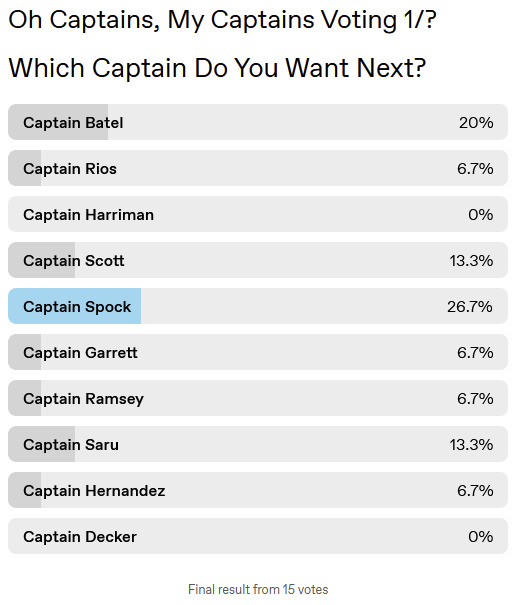
I'm 100% sure it's due entirely to people not knowing the poll existed, but where the support of Capt.'s Rios and Seven are annecdotally strong, I've got numbers for Spock, Batel, and a surprising tie for third of Scott and Saru.
Without further ado...
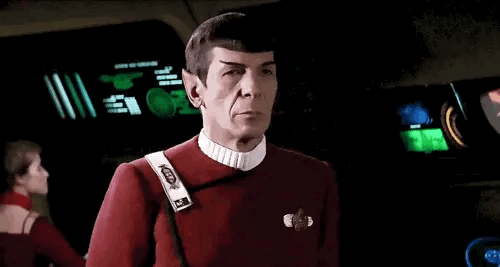
Captain Spock
At least four generations of Done With Your Shit™️. Your ideas are stupid and wrong and he can prove it mathematically...which is why he can't get enough of Kirk, weird lil' himbo twink just dual-weilds the middle finger at the No Win Situation and Spock has to check his calendar to make sure Pon Far didn't arrive early! (We get it, Spock, we've all been there, right ladies?)
Scorecard
Enterprise Captains He's Given 'The Eyebrow' to: 4
Civilizations unified: 2
Ancestors whose name rhymes with "Barthur Cronnan Spoil": 1
Amount of time he kept one ship in battle-worthy condition when all the others of its class and generation were being mothballed, destroyed, or lost to the future: 40 years
Siblings he just never talks about: 2
Category: Space Elf
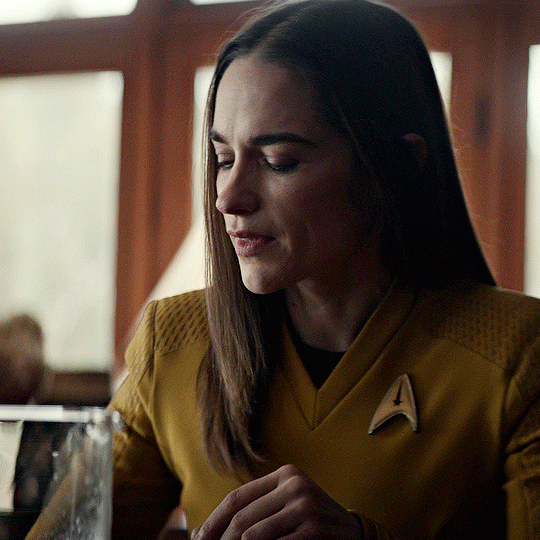
Captain Batel
Probably the one person in Starfleet that can always call out Pike on his shit. Maybe not Mom to Pike's 'Dad,' but not bad as the cool stepmom. Yes, Chris, she'll take care of Chapel while she deals with her boy issues, we'll have some girl time, it'll be fun!
Scorecard
Number of Pike fans INSANELY jealous she managed to land in Pike's bed: Like, all of them!
Number of musical numbers while in command: 1
Number of musical numbers that singing voice should have been given: ...a LOT more!
Amount of patience to deal with Pike's mid-life crisis: 9,001
Category: Step-MILF that will teach you how to drive when Dad (Pike) gets too 'back-seat-driver'-y
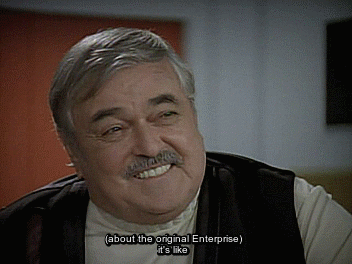
Captain Scott
Crouching Engineer, HIDDEN BADASS! Kirk may sit in the Captain's chair, but we all know who the Enterprise lets put her engines to bed for the night. This man can make any engine or transporter you can think of just sing, all in perfect accompaniment to his bagpipes.
Scorecard
Times he accidentally created a time machine (with Spock on assist): 1
Times he accidentally hosted a murdering parasite: 1
Times he out-drank an extra-galactic entity bent on stealing HIS ship: 1
Times he tested transwarp beaming with an admiral's dog: [0/1] <- YOU open the box! I'm not collapsing that waveform!
Times he unironically used the line, "There be whales here!" in a 23rd century space vessel: 1
Category: Miracle Worker

Captain Saru
Proof that a prey species can unequivocally kick your ass. Ride or die. This man will take your spaceship, captain it efficiently, and give it back to you better than when you got it. Alfred to Burnham's Batman. Might call you "Daddy," but we know who wears the belt.
Scorecard
Evolutions (you know, like Pokemon): 1
Autistic crew he's whole-heartedly supported and mentored: 1
Category: Tol Cinnamon Roll
<< First Post in this series Holy crap it's another post in this series! >>
Don't forget to vote!
#saru#captain saru#captain scott#montgomery scott#scotty#star trek#star trek: discovery#star trek discovery#star trek the original series#st: disco#disco#star trek tos#star trek disco#st: tos#star trek: the next generation#star trek the next generation#star trek tng#st:tng#batel#captain batel#marie batel#captain marie batel#star trek strange new worlds#star trek: strange new worlds#star trek snw#st: snw#spock#captain spock#ambassador spock#star trek movies
25 notes
·
View notes
Text
Character Spotlight: Data
By Ames
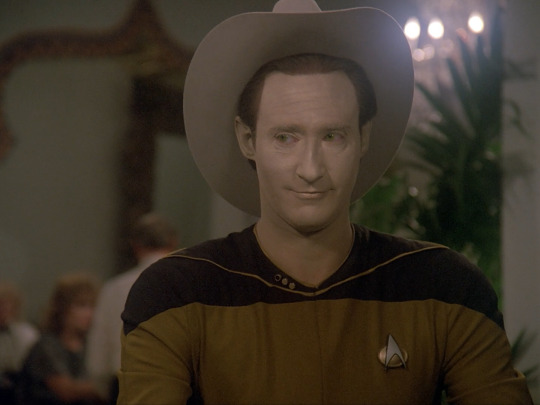
It’s the man you’ve all been waiting for! He’s one of the most popular Star Trek characters of all time. He teaches us humanity and friendship and science. He’s the outsider character of his series and uses his unique perspective to open our eyes to the world and the people around us. And he loves cats! No wait, we already spotlighted Commander Spock. Just kidding. I’m, of course, talking about Lieutenant Commander Data!
It’s hard for us at A Star to Steer Her By to narrow down the best moments from our android friend because he gets to do so damn much between The Next Generation series and movies, and he’s also my personal favorite character on the show, but we’ve somehow managed it! So use your positronic brains to read on below and listen to our discussion on this week’s podcast episode (tricorder scan to 1:03:10) to see where we drew the line. Saddle up!
[Images © CBS/Paramount]
Best moments
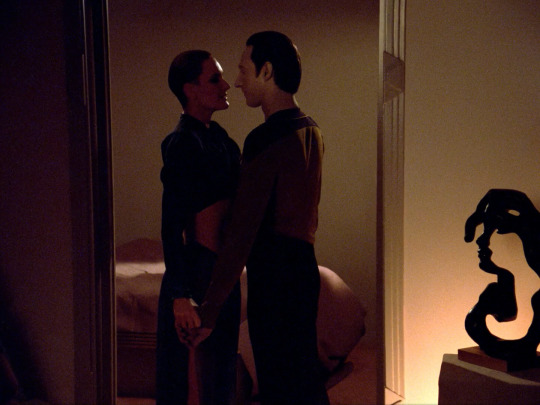
You are fully functional, aren't you? As we mentioned in our Picard spotlight, “The Naked Now” has the strangest mix of great and terrible character moments, and I couldn’t not include the incredibly hot Data/Yar romance that it created. It’s just nice to know that Data is programmed in multiple techniques, a broad variety of pleasuring. And later, the physical acting we get from Brent Spiner in that lean and fall was great!

My thoughts are not for Tasha, but for myself While the rest of “Skin of Evil” and the anticlimactic death of Tasha Yar aren’t really our cups of tea, we do have to admit that the tribute scene at the end is moving and well done. And that final moment when Data and Picard talk (even so briefly!) about the point of the ceremony and how empty it will feel without Yar… I’m tearing up just thinking about it.

Tied game, we’re going into overtime I also have to give Data credit for all the times he uses his big android brain to solve a problem, an advantage he has over pretty much any other character. For example, when he busts Sirna Kolrami up in a game of strategema by forcing a constant stalemate in “Peak Performance,” it feels like a win because he thinks outside the fluorescent holographic box!
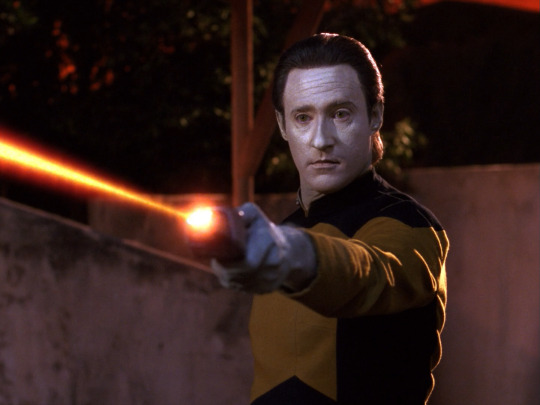
One android with a single weapon Every so often, we also see Data in command, questioning his leadership skills or having difficulty connecting with his peers (more on that one in a second). But when he’s the only one who can survive the radiation on Tau Cygna, he takes charge to get its colonists to leave by blowing up their aqueduct in “The Ensigns of Command.” Try withstanding Sheliak attacks now, losers!
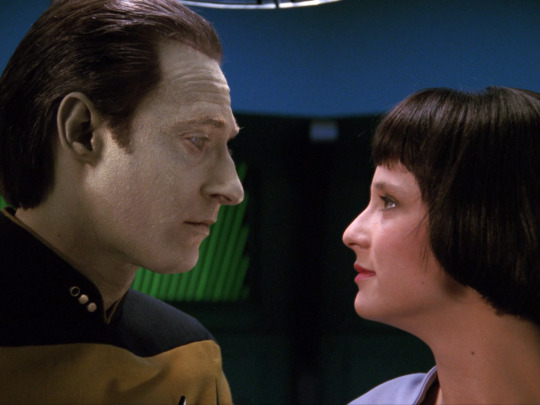
Thank you for my life While some of us on SSHB didn’t care much for Lal, you’ve got to admit that all of Data’s actions in “The Offspring” are on point. From questioning why he shouldn’t be allowed to create life, to letting his offspring self-identify, to keeping her out of the hands of Starfleet, it’s all good parenting. But what takes the cake is the heart-wrenching farewell scene after he tries to save her.
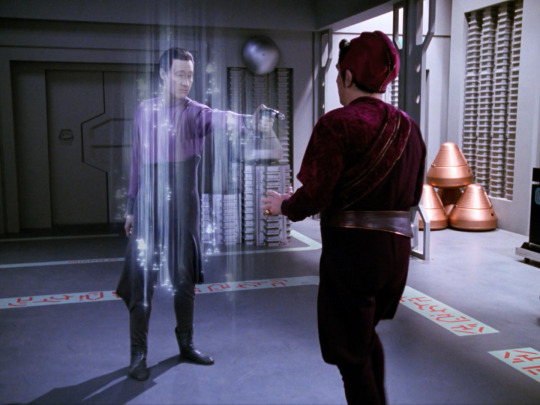
He who dies with the most toys… is kind of an asshole While we don’t get the cathartic release of Data phasering the hell out of Kivas Fajo in “The Most Toys,” we do get to take some pride that he is capable of overcoming his ethical subprogram to do away with someone who really has no right existing. When Geordi says that he detects a phaser firing in the transporter beam, you know he just needed a fraction of a second more and Fajo would be toast.
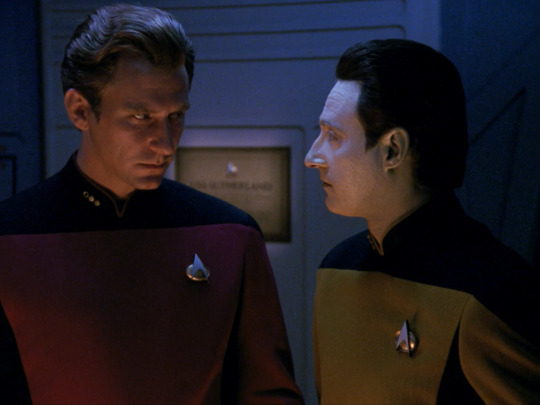
Your request for reassignment has been noted and denied Like in the afore-mentioned “The Ensigns of Command,” Data has some trouble adjusting to command when he takes control of the Sutherland in “Redemption, Part II.” It sure doesn’t help that his racist XO Hobson undermines his every decision, but that doesn’t stop Data from single-handedly foiling the Romulans’ plan and telling Hobson exactly where to shove it.
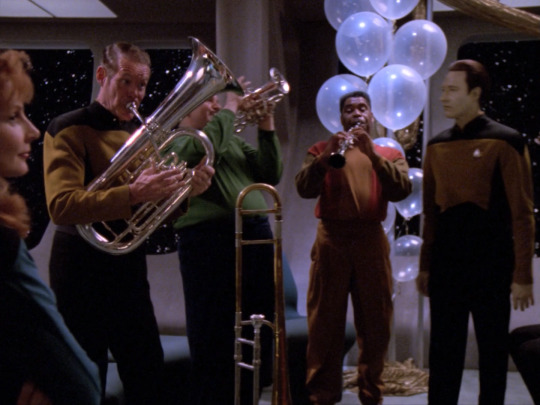
I've never been to a better funeral When it’s apparent that Geordi has been killed in a transporter accident in “The Next Phase,” Data grapples with the loss of his best friend in a very touching way, similar to how he mourned Yar as we mentioned above. And before he solves the puzzle of the episode and saves them, Data throws the best funeral I’ve ever seen for La Forge and Ro! People are just dying for a funeral like that!

The most human decision you’ve ever made We gave Picard a lot of accolades when we discussed his standing up for Data’s right to live in “The Measure of a Man.” Data gets a similar moment in “The Quality of Life” when he refuses to trade the lives of the Exocomps for those of other beings. It’s a nice episode of paying it forward, and we also get to see the scientific method on high display when he and Crusher deduce the little guys are alive.
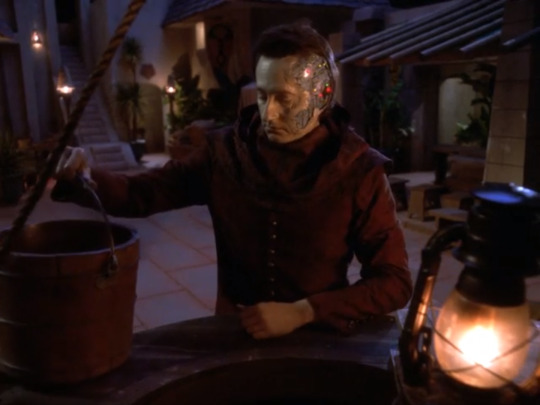
Radioactive. What does that mean? Speaking of the scientific method! Even with his memories wiped in “Thine Own Self,” Data is able to piece together why the radioactive materials are hurting everyone in the village on Barkon IV. And with that clear slate of mind, we see that in all forms, Data is curious, caring, and willing to help people who are in need, even if it gets him speared in the back a little bit.
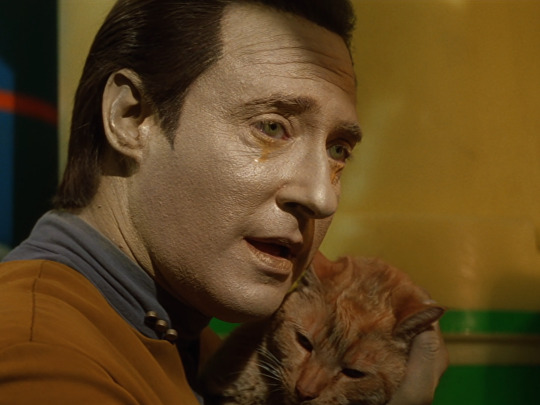
Felis catus is your taxonomic nomenclature… We’d be remiss if we didn’t bring up Data’s beautiful relationship with his cat, Spot. As everyone on SSHB is a devoted cat person, we found it a treat whenever we saw Data interacting with Spot, testing which food she’d like, and writing cat poetry. The best might be when Data reunites with her after the Enterprise crashes in Generations AND he has the emotions to appreciate it!
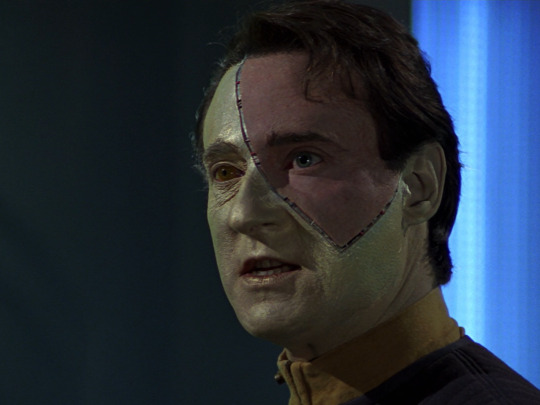
Resistance is fully functional We noticed in our TOS spotlights that it’s in the movies that most characters get to shine, and First Contact is that chance for Data. His scenes getting tempted by the Borg Queen are dead sexy and you can’t tell me otherwise. And his betrayal of the Collective by purposely sparing the Phoenix and then fumigating engineering to kill Borg Queen are the climax we all needed. I’ll be in my bunk.
—
Worst moments
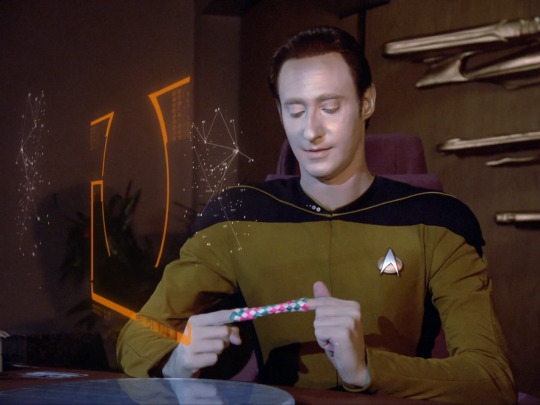
I am stuck Especially in the early seasons, Data got used to make bad fish-out-of-water jokes. It was a silly habit the show had of depicting him as naïve about human culture even though he’s lived in it for years (and has the memories of the Omicron Thetans when the show remembers). Seeing him get stuck in a fingertrap in “The Last Outpost” is just such an example of dumb sight gags to make him look goofy.

I can’t use contractions, sir This is just a pet peeve of mine that could have been fixed so damned easily. Listen, writers, if you’re going to make it a plot point that Data can’t use contractions in episodes like “Datalore” and “Future Imperfect,” then be consistent. Run an apostrophe search in Microsoft Word and replace them, because in episodes like “We’ll Always Have Paris” when he states “It’s me,” it pisses me off.
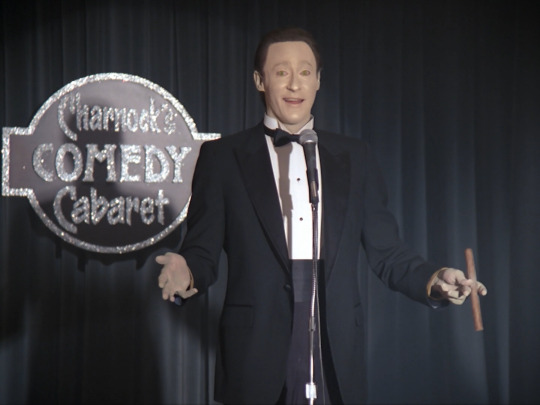
Take my Worf, please! Don’t worry, we’re not done pointing out all the bad jokes told at Data’s expense that we see throughout the series (oh god, and just wait for the movies). And it’s a shame because Brent Spiner himself has such great comic timing and delivery, but when you make his jokes so obviously idiotic like in Ames’s least favorite TNG episode “The Outrageous Okona,” we cringe so hard.

Is anybody out there? We mentioned this one in our prime directive chat before, since Data just tramples all over it, but “Pen Pals” has some good discussion on the pros and cons of the situation. But that doesn’t excuse Data for making the decision on his own to get involved with the Dramen people, much less to bring Sarjenka onto the bridge (for crying out loud), necessitating a Pulaski mind wipe!

One seven three four six seven three two one four… There are a handful of times in TNG that we find it a terrible idea that Data (or any single being) has as much power as they have, considering how often they get possessed by things or duplicated by other things. So when Data single-handedly takes over the Enterprise in “Brothers,” disrupting the mission to save Willie Potts’s life, because Soong hacked into his brain, we raise eyebrows.
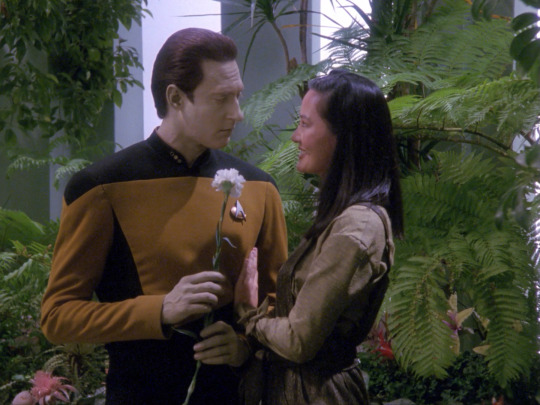
Jilting by association While I could joke that Data ever introducing Miles and Keiko was a mistake (and I have!), there’re still a lot of bad moves he makes regarding their relationship in “Data’s Day.” When he gets stuck in the middle of their nuptial stress, he’s so clueless how to handle the situation and keeps making things worse when, frankly, Miles and Keiko should have kept things to themselves.
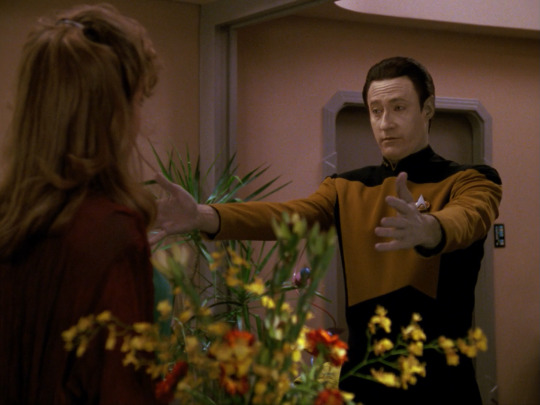
Who programmed the book of love? Moving on to even more lousy relationships: Data’s brief, unnecessary romance with Jenna Desora in “In Theory” proves to be just another example of too many “Data doesn’t understand humanity” jokes that we hoped the show was over by this point. But alas, he’s written himself a love program to basically treat the situation like a sitcom and we were done with it.
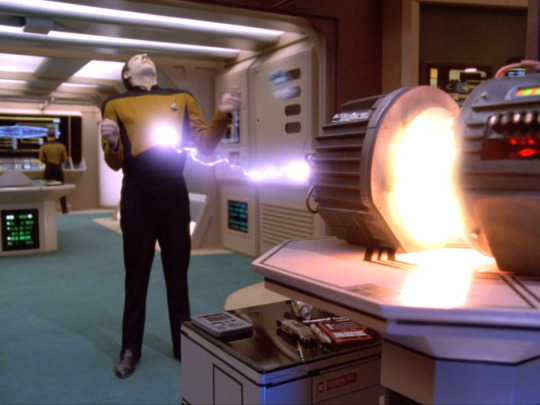
Point that thing somewhere else From the moment Data stands directly in front of Bashir’s mystery device in “Birthright, Part I,” it’s obvious he’s going to get zapped by it. Really, Data? You couldn’t have stood literally anywhere else than in front of what is clearly an energy beam? And the rest of the episode, we’re stuck going on a dream adventure, and you already know how I feel about those!
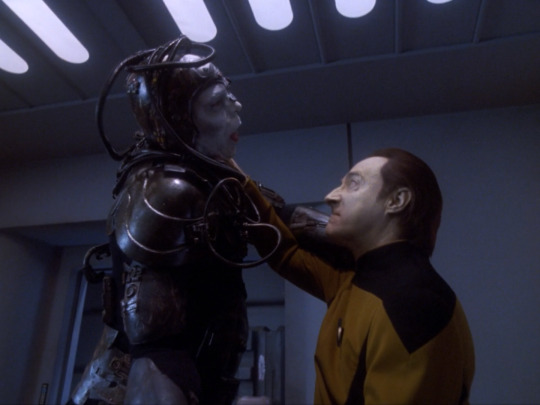
Stop it, stop it, stop it Like in “Brothers,” it just seems weird to have Data getting controlled by his kooky family members when it happens again in “Descent.” This time, Lore has given Data the emotions he thought he wanted all along, but it turns out the very first emotion Data embraces is sheer rage. When he takes pleasure in killing Borg, you know maybe emotions just aren’t for him, and yet…
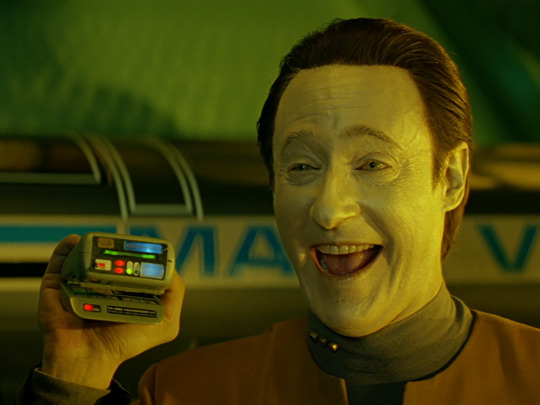
Open sesame! …when we get to Generations, Data has a fully fledged emotion chip that really needed more testing first. We’re subjected to just way too many of those dopey Data jokes, from Open Sesame to Mr. Tricorder to cackling at a 7-year-old joke. And to add kidnapping and torture to insult, it’s when Data is having a particularly bad reaction that Geordi nearly gets killed by Klingons!

I have been designed to serve as a floatation device We’re not done yet with the Data humor (and just way too much humor in general that doesn’t land) in Insurrection. While this film really gives Jean-Luc his time to shine, the rest of the cast are treated like afterthoughts, including Data who seems to be around for punchlines, like remarking about how the women’s boobs feel firmer, and serving as a life preserver.

Going out in a blaze of failure Finally, I need to criticize Nemesis yet again, as I am wont to do. It’s just… Data’s sacrifice for Picard is so unearned. I’d debate that it’s worse than the Kirk sacrifice in Generations that we put in that Worst Moments list too. Most of it is probably the abysmal script. I’ll sum it up by saying this: if you can’t make me care that my favorite character died, you’ve done something wrong.
—
Now that we’ve found Data’s off switch, we can wrap things up this week. Don’t worry, we’ve got tons more character spotlights for the coming weeks, so keep your sensors here, journey over to SoundCloud or wherever you get your podcasts to follow along with our Enterprise watchthough, break the Prime Directive with us on Facebook and Twitter, and delete that comedian holoprogram from the computer!
#star trek#star trek podcast#podcast#data#the next generation#generations#first contact#insurrection#nemesis#the naked now#skin of evil#peak performance#the ensigns of command#the offspring#the most toys#redemption#the next phase#the quality of life#thine own self#the last outpost#we'll always have paris#the outrageous okona#pen pals#brothers#data's day#in theory#birthright#descent#brent spiner
13 notes
·
View notes
Text
Best of Discovery Season 1
This year the final season of Star Trek Discovery airs, bringing an end to the show that brought Star trek back to television after over a decade absense. To celebrate its 5 season run (which was incredibly long for a streaming show, I'll be doing a best of for all the seasons of streaming era trek so far, listing great moments/scenes (at least 13, as this was meant to be a bakers dozen series), and One honorable mention.

To start off, the season that Started it all, Star Trek Discovery Season One . Spoilers below
Battle of the Binary Stars

A fleet of Starfleet ships arrive to back up the USS Shenzhou against a klingon fleet, and what a fleet it is. A whole era of Starfleet design is explored in a single scene against a goreous backdrop of the titular binary stars.
2. U.S.S. Europa arrives
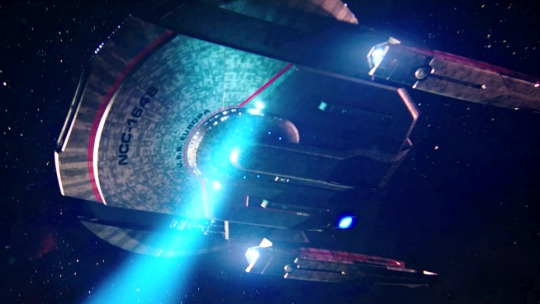
The U.S.S. Shenzhou is disable by the battle and is drifting towards an astroid when the Admiral's Flagship arrives. The Nimitz Class U.S.S. Europa arrives at the last second, tractoring the Shenzhou and calling a temporary ceasefire to the battle. It is a visually gorgeous scene with a wonderful score. For just a moment, the arrival of the mighty starship make it seem like everything might be okay.
3. U.S.S. Discovery arrives
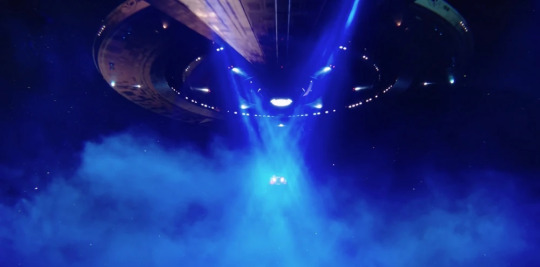
U.S.S. Discovery, the namesake off the show doesn't appear till episode 3, but she make a grand entrance, saving the prison shuttle transporting Burnham in a scene that wonderfully conveys her size and grandeur
4. The shushing Klingon
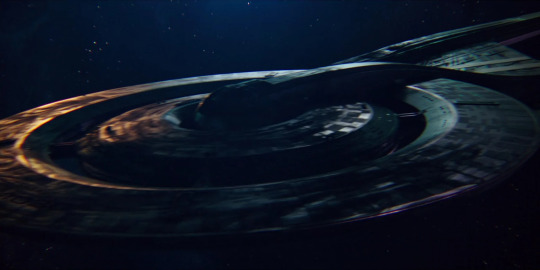
Aboard the damaged U.S.S. Glenn, a team from the U.S.S. Discovery find the crew fataly mutilated by a failed spore jump, but more immediatly threatening, a monster roams the halls of the stricken ship, one capable of killing the klingon boarding party sent to recover the ships secerts. The scenes onboard the Glenn are brutal, and wonderfully tense. It also gives us the hilarious "did that klingon just shush me?" Moment. (I chose a pic of the Glenn rather than the interior as those were more graphic than I wanted for this post)
5. The Discovery saves Corvan II
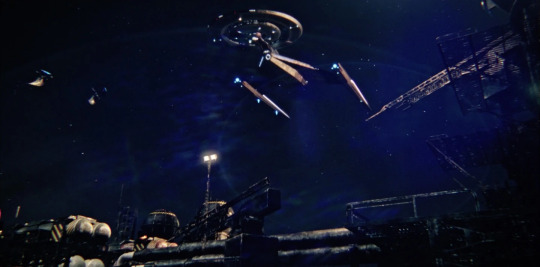
Discovery makes her first successful long range spore jump and saves the Federation mining Colony Corvan II. Its a wonderful moment od Discovery's crew coming together to save civilians.
6. Please Don't Take My Ship, She's All I Have Left
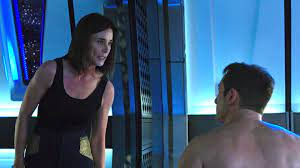
This moment between Cornwall and Lorca is amazing, and makes me wish that lorca hadn't been mirror Lorca. His plea for him to keep command off discovery is heartfelt (but later revealed to be for all the wrong reasons)
7. Mudd Loses
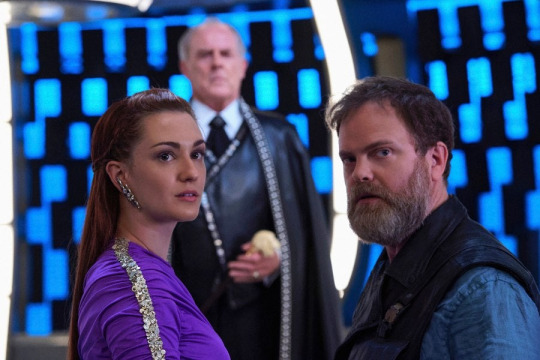
Magic to Make the Sanest Man go man is amazing throughout, but the moment the crew finally outwits Mudd is so, so satisfying.
8. The Loss of the USS Gagarin
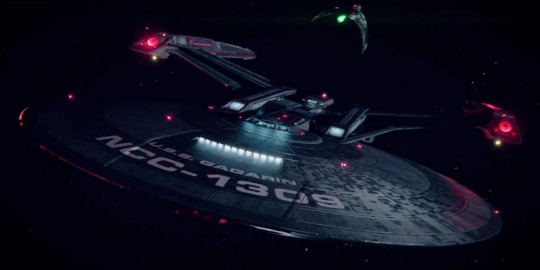
The Discovery attempts to save the U.S.S. Gagarin from the Klingopns and fails, despite their best efforts. The loss makes the war feel far more real, and highlights the fact the Discovery is just one ship, no matter her spore drive. I also love Lorca's speech here-"There will be time to grieve later"
9.Destruction of the Sarcophagus ship
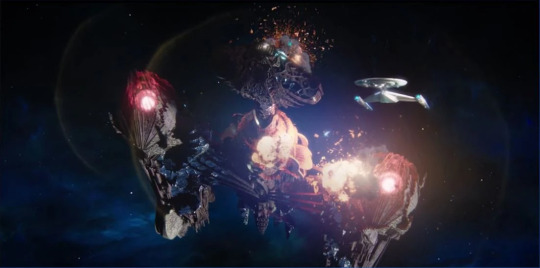
A satisfying victory for the crew, and seeing discovery make all the jumps is an epic scene.
10.Mirror Tilly...kinda
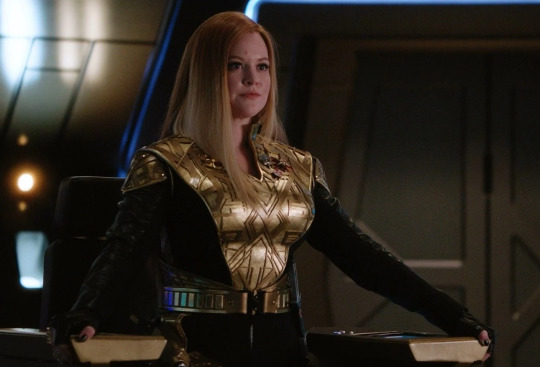
"If you spoke to me that way I would cut out your tongue to lick my boots" What a line. Tilly taking on the role of her mirror counter part is amazing.
11. I.S.S. Shenzhou
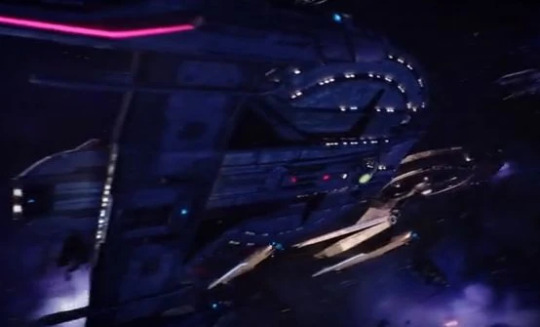
The Mirror Shenzhou arrives, and she is beautiful. A former hero ships twisted mirror half.
12. Burnham kills Captain Connor
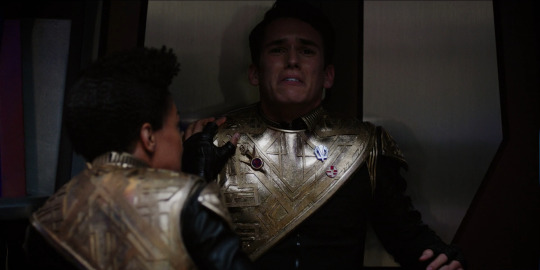
an amazing fight, and what a gut punch, as Burnham is forced to watch Connor die again, this time by her own hand. The crew clapping after the turbolift opens and his body falls out is chilling in the best way.
13. Reveal of the Imperial Palace

The I.S.S. Charon is an intimidating presense, and way cooler than a palace on a planet.
14. Destruction of the Charon and Discovery jumps Home
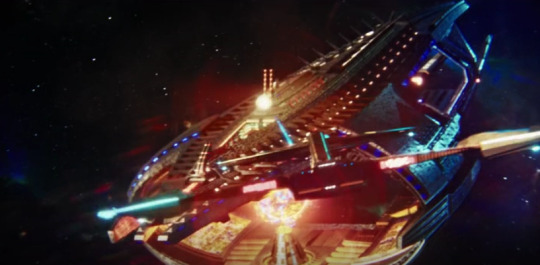
The bombing run Discovery makes on the Charon and her jump back to the prime universe using the resulting show wave is awesome, made even better on a personal layer by Burnham saving Mirror Georgiou-"I couldn't watch her die again"
15. Arrival at Qo'noS
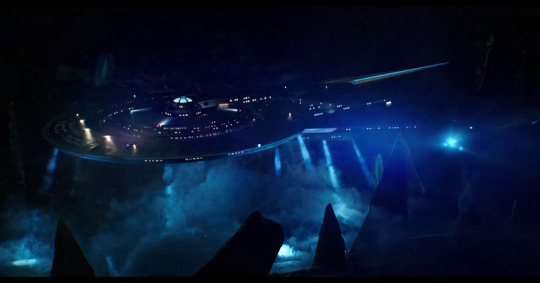
Discovery jumps to a cave on Qo'nos, and I love the weight of the scene. You can feel gravity grabbing the ship and Discovery struggling against it.
16. We are Starfleet
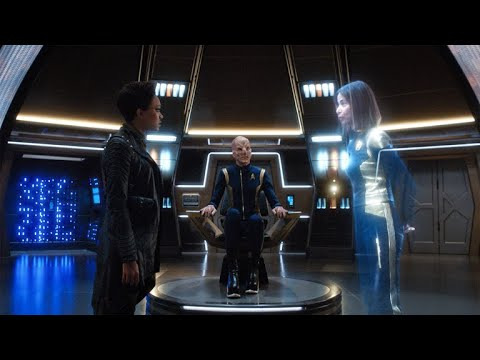
The scene the show has been building to, Burnham stands up to command over the plan to destroy the Klingon homeworld, and the crew backs her up.
17. U.S.S. Enterprise
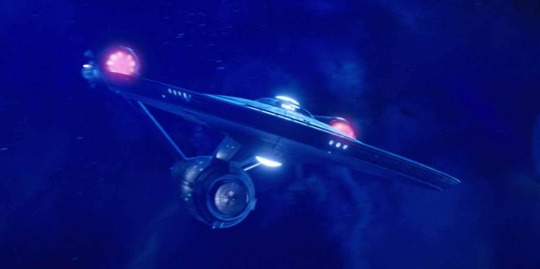
I remeber when I first saw her. The 1701 returned in all her glory. The TOS version is the definative U.S.S. Enterpise to me, but Discovery gave us an amazing earlier version. It had been decades since the prime 1701 had appeared on screen (we don't count certain series finalies) and its honestly still my favorite moment of the season.
Honorable mention: U.S.S. Discovery
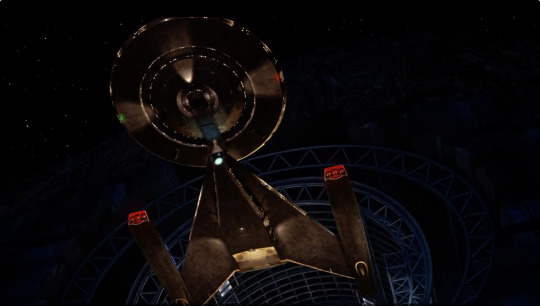
the original teaser for the show showed a much different Discovery. While I understand this was never meant to be the final, I lover her all the same. It was also the moment Trek was back, after decades we had a new hero ship. I hope STO adds her someday, and that someone makes a model of her. She may not be the offical version, but she deserves love all the same.
#star trek#star trek discovery#star trek discovery appreciation post#USS Discovery#USS Enterprise#I don't own any of the screencaps#obviously
6 notes
·
View notes